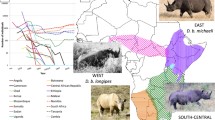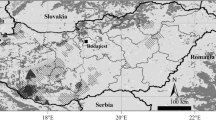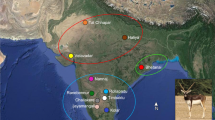Abstract
Despite an on-going struggle to conserve the endangered black rhinoceros (Diceros bicornis) since the 1980s, huge capital investment and several genetic surveys, the level of genetic structure and connectivity among populations in southern Africa is not well understood. Here, we undertake a major population genetic study of black rhinoceros in the Zimbabwe Lowveld, an area inhabited by over half of that country’s original Zambezi descendants plus one large population sourced from the relict KwaZulu stock of South Africa. Using nuclear microsatellite and mitochondrial DNA data, we found much higher levels of genetic diversity in the indigenous Zimbabwean populations, where observed multilocus heterozygosity was 0.54 versus 0.40 in KwaZulu, and maternal haplotype diversity was 0.77 versus 0.03. We show, for the first time, that both gene pools can be differentiated from each other on the basis of nuclear markers. This, along with the discovery of recent gene flow between all Lowveld populations, suggests that Zimbabwean and South African gene pools were prehistorically connected.



Similar content being viewed by others
References
Anderson-Lederer RM, Linklater WL, Ritchie PA (2012) Limited mitochondrial DNA variation within South Africa’s black rhino (Diceros bicornis minor) population and implications for management. Afr J Ecol 50:404–413
Bandelt H-J, Forster P, Röhl A (1999) Median-joining networks for inferring intraspecific phylogenies. Mol Biol Evol 16:37–48
Belkhir K, Borsa P, Chikhi L, Raufaste N, Bonhomme F (2004). GENETIX 4.02, logiciel sous Windows TM pour la génétique des populations, Laboratoire Génome, Populations, Interactions; CNRS UMR 5000; Université Montpellier II, Montpellier
Brown SM, Houlden BA (1999) Isolation and characterization of microsatellite markers in the black rhinos (D. bicornis). Mol Ecol 8:1559–1561
Brown SM, Houlden BA (2000) Conservation genetics of the black rhinoceros (D. bicornis). Conserv Genet 1:365–370
Campbell NJH, Harriss FC, Elphinstone MS, Baverstock PR (1995) Outgroup heteroduplex analysis using temperature gradient gel electrophoresis–high resolution large scale screening of DNA variation in the mitochondrial control region. Mol Ecol 4:407–418
Child GFT, Riney T (1987) Tsetse control hunting. I. Zimbabwe, 1919–1958. Zambezia 14:11–71
Cumming D, Du Toit R, Stuart SN (1990) African elephants and rhinos: Status survey and conservation action plan. IUCN, Gland
Cunningham J, Harley EH, O’Ryan C (1999) Isolation and characterization of microsatellite loci in black rhinoceros (Diceros bicornis). Electrophoresis 20:1778–1780
Drummond WH (1876) On the African rhinoceroses. Proc Zool Soc Lond 1876:109–114
Emslie R (2013) African Rhinoceroses–Latest trends in rhino numbers and poaching. An update to Doc 54-2-Annexe 2 from the IUCN Species Survival Commission’s (IUCN/SSC)
Emslie R, Brooks M (1999) African Rhino: Status survey and action plan. IUCN/SSC African rhino specialist group, Gland
Evanno G, Regnaut S, Goudet J (2005) Detecting the number of clusters of individuals using the software STRUCTURE: a simulation study. Mol Ecol 14:2611–2620
Excoffier L, Lischer HEL (2010) Arlequin suite ver 3.5: a new series of programs to perform population genetics analyses under Linux and Windows. Mol Ecol Resour 10:564–567
Fernando P, Polet G, Foead N, Ng LS, Pastorini J, Melnick DJ (2006) Genetic diverisity, phylogeny and conservation of the Javan rhinoceros (Rhinoceros sondaicus). Conserv Genet 7:439–448
Florescu A, Davila JA, Scott C, Fernando P, Kellners K, Morales JC, Melnick D, Boag PT, van Coeverden de Groot P (2003) Polymorphic microsatellites in white rhinoceros. Mol Ecol Notes 3:344–345
Fraser AD (1958) On the present status of ungulates in Southern Rhodesia. Mammalia 22:469–475
Groves CP (1967) Geographic variation in the black rhinoceros (Diceros bicornis Linnaeus, 1758). Zeitschrift fur Säugetierkunde 32:267–276
Groves CP, Grubb P (2011) Ungulate Taxonomy. Johns Hopkins University Press, Baltimore
Hall-Martin A (1979) Black rhinoceros in Southern Africa. Oryx 15(1):26–32
Harley EH (2002) AGARST, version 2.8, a program for calculating allele frequencies, GST and RST from microsatellite data. Wildlife Genetics Unit, University of Cape Town, Cape Town
Harley EH, Baumgarten I, Cunningham J, O’Ryan P (2005) Genetic variation and population structure in remnant populations of Black Rhinoceros, Diceros bicornis, in Africa. Mol Ecol 14:2981–2990
Karsten M, Jansen van Vuuren B, Goodman P, Barnaud A (2011) The history and management of black rhino in KwaZulu-Natal: a population genetic approach to assess the past and guide the future. Anim Conserv 14:363–370
Leader-Williams N (1992) The world trade in Rhinoceros horn: a review. TRAFFIC International, Cambridge
Leader-Williams N (2002) Regulation and protection: successes and failures in rhinoceros conservation. In: Oldfield S (ed) The Trade in Wildlife: Regulation for Conservation. Earthscan, London, pp 89–99
Librado P, Rozas J (2009) DnaSP v5: a software for comprehensive analysis of DNA polymorphism data. Bioinformatics 25(11):1451–1452
Milliken TKN, Thomsen JB (1993) The decline of the black rhino in Zimbabwe: implications for future rhino conservation. TRAFFIC International, Cambridge
Milliken, T, Emslie RH, Talukdar B (2009) African and Asian Rhinoceroses –Status, Conservation and Trade. In a report from the IUCN Species Survival Commission (IUCN/SSC), Gland
Moro D, Campbell NJH, Elphinstone MS, Baverstock PR (1998) The Thevenard Island mouse: historic and conservation implications from mitochondrial DNA sequence-variation. Pac Conserv Biol 4:282–288
Muya SM, Bruford MW, Muigai AW-T, Osiemo ZB, Mwachiro E, Okita-Ouma B, Goossens B (2011) Substantial molecular variation and low genetic structure in Kenya’s black rhinoceros: implications for conservation. Conserv Genet 12:1575–1588
Nei M (1978) Estimation of average heterozygosity and genetic distance from a small number of individuals. Genetics 89:583–590
Nielsen L, Meehan-Meola D, Kilbourn A, Alcivar-Warren A (2008) Characterization of microsatellite loci in the black rhinoceros (Diceros bicornis) and white rhinoceros (Ceratotherium simum): their use for cross-species amplification and differentiation between the two species. Conserv Genet 9:239–242
Paetkau D, Slade R, Burden M, Estoup A (2004) Genetic assignment methods for the direct, real-time estimation of migration rate: a simulation-based exploration of accuracy and power. Mol Ecol 13:55–65
Pritchard J, Stephens M, Donnelly P (2000) Inference of population structure using multilocus genotype data. Genetics 155:945–959
Rannala B, Mountain JL (1997) Detecting immigration by using multilocus genotypes. Proc Nat Acad Sci USA 94:9197–9201
Raymond M, Rousset F (1995) GENEPOP (version 1.2): population genetics software for exact tests and ecumenicism. J Hered 86:248–249
Rohrer GA, Alexander LJ, Keele JW, Smith TP, Beattie CW (1994) A microsatellite linkage map of the porcine genome. Genetics 136:231–244
Rosenberg NA (2004) Distruct: a program for the graphical display of population structure. Mol Ecol Notes 4:137–138
Roth HH (1967) White and black rhinoceros in Rhodesia. Oryx 9:217–231
Scott CA (2008) Microsatellite variability in four contemporary rhinoceros species: implications for conservation. Queen’s University Kingston, Kingston
Swart MKJ, Ferguson JWH (1997) Conservation implications of genetic differentiation in Southern African populations of black rhinoceros (Diceros bicornis). Conserv Biol 11:79–83
Van Coeverden de Groot PJ, Putnam AS, Erb P, Scott C, Melnick D, O’Ryan C, Boag PT (2011) Conservation genetics of the black rhinoceros, Diceros bicornis bicornis, in Namibia. Conserv Genet 12:783–792
Van Oosterhout C, Hutchinson WF, Wills DPM, Shipley P (2004) MICRO-CHECKER: software for identifying and correcting genotyping errors in microsatellite data. Mol Ecol Notes 4:535–538
Acknowledgments
We thank the International Rhino Foundation and the US Fish and Wildlife Service for financial support. We thank Steve Smith for comments on an earlier version of the manuscript.
Conflict of interest
The authors of this article have no financial or non-financial competing interests.
Funding
This work was supported by the International Rhino Foundation and the United States Fish and Wildlife Service.
Author information
Authors and Affiliations
Corresponding author
Electronic supplementary material
Below is the link to the electronic supplementary material.
Rights and permissions
About this article
Cite this article
Kotzé, A., Dalton, D.L., du Toit, R. et al. Genetic structure of the black rhinoceros (Diceros bicornis) in south-eastern Africa. Conserv Genet 15, 1479–1489 (2014). https://doi.org/10.1007/s10592-014-0632-x
Received:
Accepted:
Published:
Issue Date:
DOI: https://doi.org/10.1007/s10592-014-0632-x




